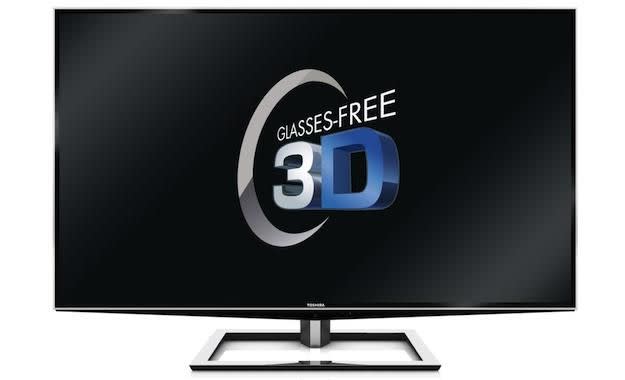Will the Toshiba ZL2 55-inch, glasses-free 3D television save 3D TV?

You may recall hearing about Toshiba’s 55ZL2 back in September last year, when the glasses-free 3D TV made a splash at the IFA show in Berlin. But with no fixed release date given at the time, plus a ridiculous price tag, it was difficult to get too excited.
Since then, Toshiba has been hard at work preparing the set for general release, and now that time has come, as the ZL2 will go on sale in the UK on 12 March, with pre-orders beginning today. Unfortunately, the price tag is almost identical to that quoted at IFA: An eye-watering £6,999, which converts over to $11, 029. No US release date has been stated.
So what do you get for such a giant amount of cash? First and foremost, what you don’t get is a pair of 3D glasses, as the ZL2 has a lenticular display instead. Combined with a camera which tracks viewer’s faces and a multi-core processor inside the set, different images are projected to the left and right eye, producing a 3D picture.
Glasses-free 3D viewing isn’t the panel’s only trick either, as it boasts a resolution of 3840 x 2160 — also known as 4K. Toshiba’s Cevo Engine controls the hybrid edge and back-lit display, providing 2D-to-3D conversion and even upscaling 1080p HD content “beyond Full HD” according to the press release.
Other features include Wi-Fi and DLNA connectivity, a full suite of online video content, social networking features, USB recording, a dedicated mobile app, a built-in subwoofer and four HDMI ports.
No 3D glasses
Toshiba’s glasses-free 3D technology differs from previous sets by using a built-in camera to track the position of your face. Whereas before it was essential to sit directly in-front of a 3D TV that didn’t use glasses, with the ZL2 it’s not as important, as the TV is aware of where you are.
While this provides a big boost to the TV’s usability, it’s the absence of 3D glasses which will be the Toshiba’s (eventual) major selling point. Often heavy, sometimes uncomfortable, and always stupid-looking and expensive, active-shutter 3D glasses are the bane of home 3D viewing. Passive glasses may be cheaper and lighter, but they’re terribly irritating if you wear glasses already.
There’s no doubt glasses-free is where 3D technology needs to be if it’s to break into the mainstream, but at more than $11,000 for the 55-inch ZL2, this isn’t the breakout model.
Has it missed the 3D boat?
We say “if it’s to break into the mainstream” because 3D still hasn’t become as ubiquitous as we were told it would be, or as the movie and TV studios may have hoped.
The format’s supporters could argue it needs more time, and as prices continue to fall, 3D will become the standard in most homes. That’s fine, except 3D content appears to be declining instead of rising.
In 2011, 47 films were released theatrically in 3D, however in 2012, that number will fall to 33. Research published in The Guardian newspaper shows that half the audiences chose to see big-name 3D animations such as The Lion King and Kung Fu Panda 2 in 2D, as did those who saw Harry Potter and the Deathly Hallows Part 2.
Even genre-based, three-dimensional money-makers such as Halloween 3D and Piranha 3DD have yet to be given release dates, and in the case of the former, has been put on hold indefinitely.
It’s a similar story at home, with only the 2012 Olympic opening and closing ceremony, some highlights and the 100m final being broadcast in 3D. Bandwidth problems may be to blame, but it’s still a missed opportunity.
Glasses-free displays and better content could win through
Clash of the Titans, Transformers: Dark of the Moon, Mars Needs Moms. Three examples of very poor films, which happened to be in 3D, released last year. If that’s what’s available to buy on Blu-ray for a shiny new 3D TV, it’s no wonder it’s struggling to succeed.
However, by removing the barrier between your eyes and the screen, 3D TV will be a considerably easier sell when the sets become more affordable.
Also, films such as Hugo 3D and Cave of Forgotten Dreams, plus forthcoming 3D titles such as Prometheus, The Avengers and the double-whammy of The Hobbit — shot in 3D and 4K, perfect for the ZL2 — 3D could still save itself from the same fate as its 1950s counterpart.
It’s just going to have to work very hard to do so.
This article was originally posted on Digital Trends
More from Digital Trends
Active vs. passive 3D TV technology: What’s the difference?
3D TV Buyer’s Guide: 2011 Edition
